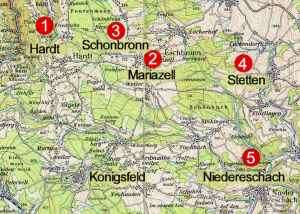


Early in the morning we packed up our camera equipment and left to meet with the first eyewitness, Gerhard Jackle, who would also be our guide on the first few days. Mr. Jackle was a 14 year old school boy on March 18, 1944, and remembers that day “like it was yesterday”. Also with Mr. Jackle were 2 reporters, one from the local paper and one from the regional paper that covers the Black Forest region. There seemed to be a lot of interest in our visit to this region as the reporters would be with us for two days. Driving for about 15 minutes we came to our first stop.
The town of Mariazell, crash site of Lt. Rex L. Johnson. The German report (KU1254) we found at the National Archives listed the following: place of crash - Mariazell near Schramberg, County of Rottweil; kind of capture - by fighter (ascertained); type of aircraft - Liberator; markings - not to identify (burned); condition of aircraft - 95% crash, partly burned; remarks - 2 men of the crew were recovered dead, 3 men burned inside of the plane, nothing is known about the fate of the others.
Standing at the top of the hill overlooking Mariazell, Mr. Jackle told what he experienced back then. Carsten Kohlmann translated, “German fighters attacked the US bombers; here at this spot is the crash of one of the Liberators." He continued, “I can still remember, we counted them, around 1500 airplanes.”
Carsten Kohlmann stopped the translation, turned to me and asked, “This is possible, to have these many aircrafts?"
I responded, “Yes many planes, B-17 and B-24?"
Carsten relayed my response and Jackle answered, “Yes, both." Jackle continued,” The bombers were enroute to the armaments center in Friedrichshafen with their fatal cargo of bombs. It was half-past twelve in the morning. The bombers came over for 2 hours; then after an hour of quietness, the 1st came back, and at 3:00 it was the 392nd Bomber Group, with no fighter support."
He and the neighborhood children followed the scary scene full of fascination. “It was the first time we really experienced something from the war. In the afternoon we heard the familiar humming in the air again. This time there were fewer airplanes in sight. Suddenly there was a high pitched noise mixing with the droning. The origin of the noise was visible in the sky. Nine German fighters appeared out of the north and began immediately firing upon the bombers. White puffs came from the planes, and some of them began to fall. One airplane was crashed near Hardt; another plane exploded near Schonbronn and fell to the ground in several pieces. A bomber came down here in Mariazell and Stetten”.
Mr. Jackle could remember every detail of the crashes, “One day after the battle (Sunday) I was walking towards Schonbronn with my friends towards the crash site and saw a dead American flyer. I also pick up a radio and pieces of chocolate in the field around the crash before a German soldier chased us away. At first there were no guards at the crash in Mariazell. My friends and I approached the crash site. In the burning plane there was still a young airman crying for help in English. There is a hole in the ground, and next to it lay an airman whose parachute did not open. He lay on his back with his mouth opened, and it was full of goldcrowns. These events are still engraved in my memory even today though I am now 62 years old."
In the afternoon in the town of Mariazell, another eyewitness Karl Hilser, who was 30 years old on the day of the crash, told his story. “I was on leave from the army with my wife and small child. When the planes came over, we hid in the basement of our home. When the bomber hit the ground, I grabbed my rifle and went to the crash site in the field about 500 meters from the present day sports arena in town. What appeared before me was horrible. An American was in the soggy ground up to his waist, dead and flattened. Presumably he jumped too late, and his parachute didn’t have time to open. Out of the burning wreck came a piercing cry for help. I was near the burning wreckage when suddenly explosions, bing, bing, bing. They were continuous explosions. I wanted to help, but I couldn’t get near the wreckage." I put my hand on Mr. Hilsner’s shoulder, and he continued, “ We regular soldiers had no hate for the Americans. The hate was for the SS and the Nazi swine."
After our meeting with the witnesses of Mariazell, Gerhard Jackle took us to the place where the survivor of the crash, Delmar Johnson, landed in his parachute. It was near a farm house, and we were told that the people at the farm were good to him. Today, Delmar Johnson is 74, a member of the 392nd Memorial Association, and lives in California. Now on to Stetten and the crash site of Lt. Ellsworth F. Anderson and crew.